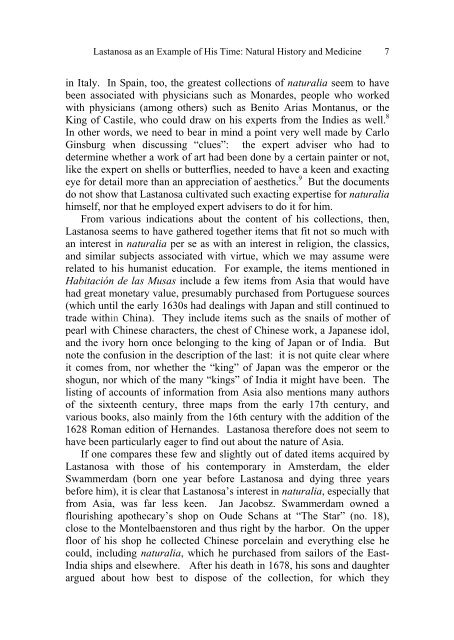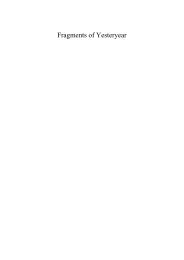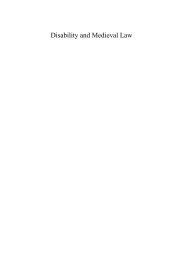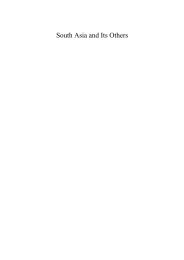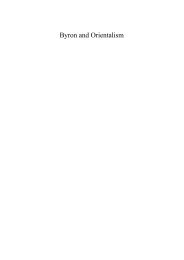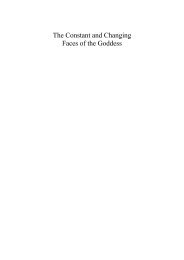The Gentleman, the Virtuoso, the Inquirer - Cambridge Scholars ...
The Gentleman, the Virtuoso, the Inquirer - Cambridge Scholars ...
The Gentleman, the Virtuoso, the Inquirer - Cambridge Scholars ...
You also want an ePaper? Increase the reach of your titles
YUMPU automatically turns print PDFs into web optimized ePapers that Google loves.
Lastanosa as an Example of His Time: Natural History and Medicine<br />
in Italy. In Spain, too, <strong>the</strong> greatest collections of naturalia seem to have<br />
been associated with physicians such as Monardes, people who worked<br />
with physicians (among o<strong>the</strong>rs) such as Benito Arias Montanus, or <strong>the</strong><br />
King of Castile, who could draw on his experts from <strong>the</strong> Indies as well. 8<br />
In o<strong>the</strong>r words, we need to bear in mind a point very well made by Carlo<br />
Ginsburg when discussing “clues”: <strong>the</strong> expert adviser who had to<br />
determine whe<strong>the</strong>r a work of art had been done by a certain painter or not,<br />
like <strong>the</strong> expert on shells or butterflies, needed to have a keen and exacting<br />
eye for detail more than an appreciation of aes<strong>the</strong>tics. 9 But <strong>the</strong> documents<br />
do not show that Lastanosa cultivated such exacting expertise for naturalia<br />
himself, nor that he employed expert advisers to do it for him.<br />
From various indications about <strong>the</strong> content of his collections, <strong>the</strong>n,<br />
Lastanosa seems to have ga<strong>the</strong>red toge<strong>the</strong>r items that fit not so much with<br />
an interest in naturalia per se as with an interest in religion, <strong>the</strong> classics,<br />
and similar subjects associated with virtue, which we may assume were<br />
related to his humanist education. For example, <strong>the</strong> items mentioned in<br />
Habitación de las Musas include a few items from Asia that would have<br />
had great monetary value, presumably purchased from Portuguese sources<br />
(which until <strong>the</strong> early 1630s had dealings with Japan and still continued to<br />
trade within China). <strong>The</strong>y include items such as <strong>the</strong> snails of mo<strong>the</strong>r of<br />
pearl with Chinese characters, <strong>the</strong> chest of Chinese work, a Japanese idol,<br />
and <strong>the</strong> ivory horn once belonging to <strong>the</strong> king of Japan or of India. But<br />
note <strong>the</strong> confusion in <strong>the</strong> description of <strong>the</strong> last: it is not quite clear where<br />
it comes from, nor whe<strong>the</strong>r <strong>the</strong> “king” of Japan was <strong>the</strong> emperor or <strong>the</strong><br />
shogun, nor which of <strong>the</strong> many “kings” of India it might have been. <strong>The</strong><br />
listing of accounts of information from Asia also mentions many authors<br />
of <strong>the</strong> sixteenth century, three maps from <strong>the</strong> early 17th century, and<br />
various books, also mainly from <strong>the</strong> 16th century with <strong>the</strong> addition of <strong>the</strong><br />
1628 Roman edition of Hernandes. Lastanosa <strong>the</strong>refore does not seem to<br />
have been particularly eager to find out about <strong>the</strong> nature of Asia.<br />
If one compares <strong>the</strong>se few and slightly out of dated items acquired by<br />
Lastanosa with those of his contemporary in Amsterdam, <strong>the</strong> elder<br />
Swammerdam (born one year before Lastanosa and dying three years<br />
before him), it is clear that Lastanosa’s interest in naturalia, especially that<br />
from Asia, was far less keen. Jan Jacobsz. Swammerdam owned a<br />
flourishing apo<strong>the</strong>cary’s shop on Oude Schans at “<strong>The</strong> Star” (no. 18),<br />
close to <strong>the</strong> Montelbaenstoren and thus right by <strong>the</strong> harbor. On <strong>the</strong> upper<br />
floor of his shop he collected Chinese porcelain and everything else he<br />
could, including naturalia, which he purchased from sailors of <strong>the</strong> East-<br />
India ships and elsewhere. After his death in 1678, his sons and daughter<br />
argued about how best to dispose of <strong>the</strong> collection, for which <strong>the</strong>y<br />
7


